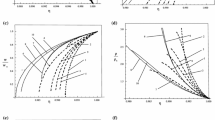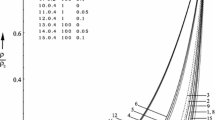Abstract
Similarity solutions are obtained for one-dimensional unsteady isothermal and adiabatic flows behind a strong exponential cylindrical shock wave propagating in a rotational axisymmetric dusty gas, which has variable azimuthal and axial fluid velocities. The shock wave is driven by a piston moving with time according to an exponential law. Similarity solutions exist only when the surrounding medium is of constant density. The azimuthal and axial components of the fluid velocity in the ambient medium are assumed to obey exponential laws. The dusty gas is assumed to be a mixture of small solid particles and a perfect gas. To obtain some essential features of the shock propagation, small solid particles are considered as a pseudo-fluid; it is assumed that the equilibrium flow conditions are maintained in the flow field, and that the viscous stresses and heat conduction in the mixture are negligible. Solutions are obtained for the cases when the flow between the shock and the piston is either isothermal or adiabatic, by taking into account the components of the vorticity vector. It is found that the assumption of zero temperature gradient results in a profound change in the density distribution as compared to that for the adiabatic case. The effects of the variation of the mass concentration of solid particles in the mixture \(K_p\), and the ratio of the density of solid particles to the initial density of the gas \(G_a\) are investigated. A comparison between the solutions for the isothermal and adiabatic cases is also made.






Similar content being viewed by others
References
Zel’dovich, YaB, Raizer, Yu P.: Physics of Shock Waves and High Temperature Hydrodynamic Phenomena, vol. II. Academic Press, New York (1967)
Sagdeev, R.Z.: Reviews of plasma physics. In: Leontovich, M.A. (ed) Consultants Bureau, New York, vol. 4 (1966)
Chen, F.F.: Introduction to Plasma Physics. Plenum, New York (1974). Chapter 8
Chaturani, P.: Strong cylindrical shocks in a rotating gas. Appl. Sci. Res. 23, 197–211 (1970)
Sakurai, A.: Propagation of spherical shock waves in stars. J. Fluid Mech. 1, 436–453 (1956)
Nath, O., Ojha, S.N., Takhar, H.S.: Propagation of a shock wave in a rotating interplanetary atmosphere with increasing energy. J. Mhd. Plasma Res. 8, 269–282 (1999)
Pai, S.I., Menon, S., Fan, Z.Q.: Similarity solution of a strong shock wave propagation in a mixture of a gas and dust particles. Int. J. Eng. Sci. 18, 1365–1373 (1980)
Higashino, F., Suzuki, T.: The effect of particles on blast wave in a dusty gas. Z. Naturforsch 35a, 1330–1336 (1980)
Miura, H., Glass, I.I.: On the passage of a shock wave through a dusty gas layer. Proc. Roy. Soc. Lond. A 385, 85–105 (1983)
Gretler, W., Regenfelder, R.: Strong shock wave generated by a piston moving in a dust-laden gas under isothermal condition. Eur. J. Mech. B/Fluids 24, 205–218 (2005)
Popel, S.I., Gisko, A.A.: Charged dust and shock phenomena in the solar system. Nonlinear Process. Geophys. 13, 223–229 (2006)
Vishwakarma, J.P., Nath, G.: Similarity solutions for unsteady flow behind an exponential shock in a dusty gas. Phys. Scri. 74, 493–498 (2006)
Vishwakarma, J.P., Nath, G.: A self-similar solution of a shock propagation in a mixture of a non-ideal gas and small solid particles. Meccanica 44, 239–254 (2009)
Vishwakarma, J.P., Nath, G.: Propagation of a cylindrical shock wave in a rotating dusty gas with heat-conduction and radiation heat flux. Phys. Scri. 81, 045401(9pp) (2010)
Vishwakarma, J.P., Nath, G.: Similarity solution for a cylindrical shock wave in a rotational axisymmetric dusty gas with heat conduction and radiation heat flux. Commun Nonlinear Sci Numer Simul. 17, 154–169 (2012)
Igra, O., Hu, G., Falcovitz, J., Wang, B.Y.: Shock wave reflection from a wedge in a dusty gas. Int. J. Multiph. Flow 30, 1139–1169 (2004)
Sommerfeld, M.: The unsteadiness of shock waves propagating through gas-particle mixtures. Exp. Fluids 3, 197–206 (1985)
Conforto, F.: Wave features and group analysis for an axi-symmetric model of a dusty gas. Int. J. Nonlinear Mech. 35, 925–930 (2000)
Elperin, T., Ben-Dor, G., Igra, O.: Head-on collision of normal shock waves in dusty gases. Int. J. Heat Fluid Flow 8, 303–312 (1987)
Miura, H.: Decay of shock waves in a dusty-gas shock tube. Fluid Dyn. Res. 6, 251–259 (1990)
Vishwakarma, J.P., Nath, G., Singh, K.K.: Propagation of shock waves in a dusty gas with heat conduction, radiation heat flux and exponentially varying density. Phys. Scr. 78, 035402(11pp) (2008)
Nath, G.: Propagation of a strong cylindrical shock wave in a rotational axisymetric dusty gas with exponentially varying density. Res. Astron. Astrophys. 10, 445–460 (2010)
Sedov, L.I.: Similarity and Dimensional Methods in Mechanics. Mir Publishers, Moscow (1982)
Ranga Rao, M.P., Ramana, B.V.: Unsteady flow of a gas behind an exponential shock. J. Math. Phys. Sci. 10, 465–476 (1976)
Vishwakarma, J.P., Nath, G.: Similarity solutions for the flow behind an exponential shock in a non- ideal gas. Meccanica 42, 331–339 (2007)
Singh, J.B., Vishwakarma, P.R.: Unsteady isothermal flow of a gas behind an exponential shock in magnetogasdynamics. Astrophys. Space Sci. 95, 111–116 (1983)
Miura, H., Glass, I.I.: Development of the flow induced by a piston moving impulsively in a dusty gas. Proc. Roy. Soc. Lond. A 397, 295–309 (1985)
Korobeinikov, V.P.: Problems in the theory of point explosion in gases. In: Proceedings of the Steklov Institute of Mathematics, No. 119. American Mathematical Society, Providence (1976)
Steiner, H., Hirschler, T.: A self-similar solution of a shock propagation in a dusty gas. Eur. J. Mech. B/Fluids 21, 371–380 (2002)
Levin, V.A., Skopina, G.A.: Detonation wave propagation in rotational gas flows. J. Appl. Mech. Tech. Phys. 45, 457–460 (2004)
Nath, G.: Magnetogasdynamic shock wave generated by a moving piston in a rotational axisymmetric isothermal flow of perfect gas with variable density. Adv. Space Res. 47, 1463–1471 (2011)
Rosenau, P., Frankenthal, S.: Equatorial propagation of axisymmetric magnetohydrodynamic shocks I. Phys. Fluids 19, 1889–1899 (1976)
Higashino, F.: Characteristic method applied to blast waves in a dusty gas. Z. Naturforsch 38a, 399–406 (1983)
Liberman, M.A., Velikovich, A.L.: Self-similar spherical expansion of a laser plasma or detonation products into a low-density ambient gas. Phys. Fluids 1, 1271–1276 (1989)
Pai, S.I.: Two Phase Flows, Chap. V. Vieweg Tracts in Pure Applied Physics vol. 3. Vieweg, Braunschweig (1977)
Geng, J.H., Groenig, H.: Dust suspensions accelerated by shock waves. Exp. Fluids 28, 360–367 (1980)
Hirschler, T., Steiner, H.: A self-similar solution for the implosion problem in a dusty gas. Fluid Dyn. Res. 32, 61–67 (2003)
Laumbach, D.D., Probstein, R.F.: Self-similar strong shocks with radiation in a decreasing exponential atmosphere. Phys. Fluids 13, 1178–1183 (1970)
Sachdev, P.L., Ashraf, S.: Conversing spherical and cylindrical shocks with zero temperature gradient in the rear flow-field. J. Appl. Math. Phys. (ZAMP) 22, 1095–1102 (1971)
Nath, G.: Shock waves generated by a piston moving in a non-ideal gas in the presence of a magnetic field: isothermal flow. South East Asian J. Math. Sci. 5, 69–83 (2007)
Zhuravskaya, T.A., Levin, V.A.: The propagation of converging and diverging shock waves under intense heat exchange conditions. J. Appl. Math. Mech. 60, 745–752 (1996)
Vishwakarma, J.P., Nath, G.: Converging detonation waves in a dusty gas. J. Tech. Phys. 47, 159–173 (2006)
Marble, F.E.: Dynamics of dusty gases. Annu. Rev. Fluid Mech. 2, 397–446 (1970)
Moelwyn-Hughes, E.A.: Physical Chemistry. Pergamon Press, London (1961)
Igra, O., Falcovitz, J., Reichenbach, H., Heilig, W.: Experimental and numerical study of the interaction between a planar shock wave and a square cavity. J. Fluid Mech. 313, 105–130 (1996)
Igra, O., Wu, X., Falcovitz, J., Meguro, T., Takayama, K., Heilig, W.: Experimental and theoretical study of shock wave propagation through double-bend ducts. J. Fluid Mech. 437, 255–282 (2001)
Falcovtiz, J., Alfandary, G., Ben-Dor, G.: Numerical simulation of the head-on reflection of a regular reflection. Int. J. Numer. Methods Fluids 17, 1055–1077 (1993)
Falcovitz, J., Ben-Artzi, M.: Recent developments of the GRP method. JSME Int. J. B. 38, 497–517 (1995)
Hutchens, G.J.: Approximate cylindrical blast theory: nearfield solutions. J. Appl. Phys. 77, 2912–2915 (1995)
Acknowledgments
The author is thankful to Dr. J. P. Vishwakarma, Professor of Mathematics DDU Gorakhpur University Gorakhpur-273009, India, for his valuable suggestions and discussions.
Author information
Authors and Affiliations
Corresponding author
Additional information
Communicated by A. Merlen.
Appendix
Appendix
From the basic equations of continuity, momentum and energy in Eulerian co-ordinates for the rotational axisymmetric flow of the mixture of a perfect gas and small solid particles with the similarity transformations
(where the variable \(\eta \) assumes the value of 1 at the shock front and \(\eta _p\) on the piston surface, such that the piston radius \(r_{\mathrm{p}} =\eta _{p} R\), with \(R (\sim \! t^{n+1})\) being the shock radius), we obtain
The boundary conditions for a strong shock in the mixture at \(\eta =1\) are given by
where it was necessary to use \(\alpha =\delta =\frac{n}{n+1}\) for existence of similarity solutions. In addition to the shock conditions (71), the kinematic condition \(V(\eta _p)=(n+1)\) at the piston surface must be satisfied.
From equations (66) and (70), one can get the relation
where \(C_1\) is a constant to be determined from (71).
Rights and permissions
About this article
Cite this article
Nath, G. Self-similar solutions for unsteady flow behind an exponential shock in an axisymmetric rotating dusty gas. Shock Waves 24, 415–428 (2014). https://doi.org/10.1007/s00193-013-0474-3
Received:
Revised:
Accepted:
Published:
Issue Date:
DOI: https://doi.org/10.1007/s00193-013-0474-3




